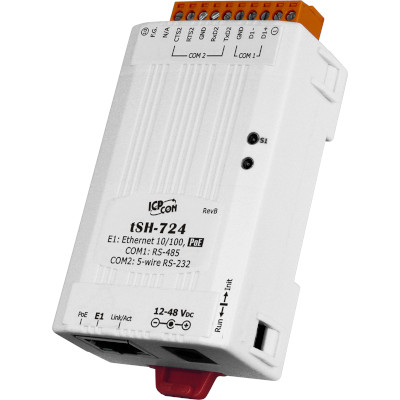
tSH-724 CR
Tiny Serial Port Baud Rate and Modbus RTU/ASCII Converter with PoE, 1 RS-485 and 1 RS-232 Port
- Supports Baud Rate conversion application
- Supports Modbus RTU/ASCII protocol conversion
- Supports two masters sharing one slave port for tSH-73x Series only
- Raw data mode for most query-response protocols
- Built-in web server for easy configuration (HTTP)
- Redundant power inputs: PoE (IEEE 802.3af, Class 1) and DC jack
- Allows automatic RS-485 direction control
- Tiny form-factor and low power consumption
INTRODUCTION
Following the success of the original tGW-700/tDS-700 modules, ICP DAS has continued to develop new functions for these products in order to provide increased support for a greater number of applications. The tSH-700 module is a serial port sharer that provides a number of functions, including "Baud Rate Conversion", "Modbus RTU/ASCII Conversion" and "Two Masters Share One Slave". The built-in web server provides easy configuration interface, and no console commands are required.
● Baud Rate Conversion: This function allows a single master device to communicate with slave devices using different baud rates and data formats. Most query-response protocols (half-duplex), e.g. DCON, are supported in the raw data mode. Full-duplex communication should also work when the data size is smaller than the built-in 512 bytes buffer on each serial port.
● Modbus RTU/ASCII Conversion: This function allows a single Modbus RTU/ASCII master device to communicate with Modbus RTU/ASCII slave devices using different protocols, baud rates and data formats.
● Two Masters Share One Slave: This function allows two master devices connected to different serial ports to share slave devices. Modbus mode can be used to convert the Modbus RTU/ASCII protocols, while raw data mode can be used for DCON or other query-response protocols. Different baud rates and data formats can also be used on the different serial ports. The built-in cache function reduces the loading of serial communication on the slave port by removing duplicated queries when the two master devices are requesting the same information.
Note: It's recommended to have large timeout value and scan interval settings on the two masters, since the slave port is now having double loadings.
APPLICATIONS
● Factory, Building and Home Automation
● Accessing a Process Controller from Local Panel and Control Center
● Control Office Lightings from Two HMI Devices (Masters) in Different Places
SYSTEM SPECIFICATIONS
System
CPU: 32-bit ARM
Communication Interface
Ethernet: 10/100 Base-TX, 8-pin RJ-45 x 1 (Auto-negotiating, Auto-MDI/MDIX, LED indicator)
PoE (IEEE 802.3af, Class 1)
COM1: 2-wire RS-485
COM2: 3-wire RS-232
COM3: -
Self-Tuner: Yes, automatic RS-485 direction control
RS-485 Bias Resistor: Yes, 1 KΩ
RS-485 Node: 254 (max.)
UART: 16c550 or compatible
Power Isolation: 1000 VDC for tSH-722i / 732i only
Signal Isolation: 3000 VDC for tSH-725i / 735i / 724i / 734i only
ESD Protection: +/-4 kV
COM Port Format
Baud Rate: 115200 bps Max.
Data Bit: 5, 6, 7, 8
Parity: None, Odd, Even, Mark, Space
Stop Bit: 1, 2
Power
Power Input PoE: IEEE 802.3af, Class 1
Power Input DC Jack: +12 ~ 48 VDC
Power Consumption: 0.07 A @ 24 VDC
Mechanism
Connector: 10-Pin Removable Terminal Block x 1
Mounting: DIN-Rail
Environment
Operating Temperature: -25 ~ +75 °C
Storage Temperature: -30 ~ +80 °C
Humidity: 10 ~ 90% RH, non-condensing


